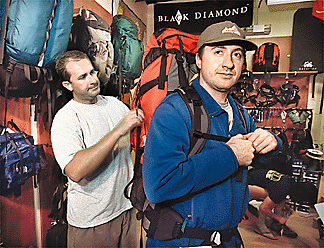


Choosing the right pack for hiking and mountain climbing is a highly personal endeavor. Finding the perfect fit
When approached with the idea of buying a pack as a gift, Demian Beyer, manager of Hawaii Outdoor World, declined to be an accomplice to such an endeavor.
Shaun Willhite, store manager at Powder Edge was equally adamant. "One pack does not fit all," said Willhite.
Many factors go into choosing the right pack for your own use.
The two most important criteria seem to be finding a pack that 1) fits the uses you intend for it and 2) fits you.
With those goals in mind, the first major decision confronting the backpack buyer is whether to go with an internal or external frame.
External frames are the old fashioned kind. According to Beyer they are the pack favored by boy scouts. This is not necessarily bad, boy scouts know a thing or two about hiking.
But if you are basically looking for a rugged piece of luggage, this is not the way to go. The exposed skeletons of external frame packs do not travel as well through the airline baggage process as internal frame packs. They also do not come with as many features designed for civilized travel. For example, many internal frame packs sport removable day packs, ideal for exploring your destination after you have dumped the bulky baggage at your hotel.
An external frame is worth consideration, however, if you are primarily looking for hiking equipment.
According to Shawn Fujimoto, a salesman with Sports Authority on Ward Avenue, these packs distribute weight to a hiker's hips and legs, which can be more comfortable over long distances for some body types. Internal frame packs, by comparison, distribute weight throughout the back.
Neither external or internal packs should put much weight on your shoulders, according to Willhite. If you have a pack that does, you either have a poorly made pack or a poor fit, he said.
External frame packs carry more weight to volume and they carry it away from the hiker's body.
And some features designed for the hiker are more common on external frame packs than their internal frame cousins. They included easy-to-reach water bottle holders and rain flaps that pull down over the top of the pack and protect it from wet weather; a handy feature for any Hawaii hiker.
But the trend has been toward internal frame packs and many seasoned hikers swear by them.
Comfort and compactness were two common reasons for their preference. Unlike external frame packs, these packs come with thick padding as they sit right on the hiker's body. This can get pretty warm, but the better manufacturers are coming out with fabrics and foams designed to reduce that problem.
Many hikers find this cosy placement advantageous because having a pack that can be molded to their bodies gives them a greater sense of stability on the trail.
Again, the choice here is personal. Both Beyer and Willhite said the best way to buy a pack is to pick one you like, then weight it down and walk around the store for a while.
The investment of time and careful shopping will pay off.
The right pack and shoes are the most important ingredients in any successful trip, said Willhite.
Click for online
calendars and events.